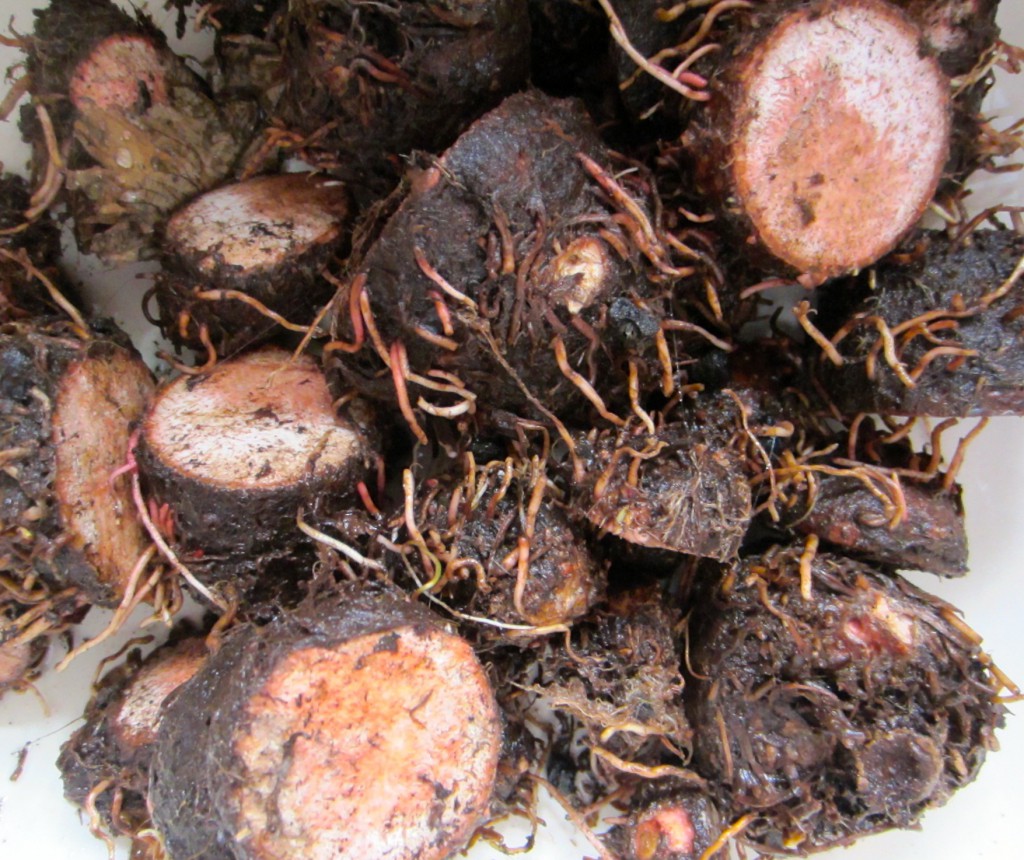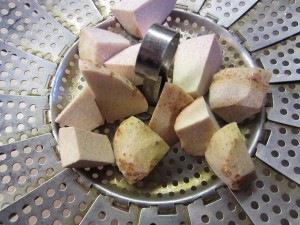
5 or more T. butter, divided
3/4 pound local, if possible, ground beef
1 medium sweet onion, peeled and diced
2 green onions, chopped
1 large carrot, peeled and grated
1/2 tsp. Hawaiian salt
1 large or various sized taro to equal about 1 pound, boiled or steamed until soft (about 20 or more minutes), peeled and mashed
1 egg
Adapted from The Electric Kitchen (Hawaiian Electric Co.), Honolulu Star Advertiser, 9/12/12
In saute pan over medium heat, melt 2 T. butter. Add ground beef, onions, green onions, carrot, and salt,  and cook 5 to 7 minutes. Drain any liquid in pan and set aside to cool.
and cook 5 to 7 minutes. Drain any liquid in pan and set aside to cool.
In large mixing bowl, combine beef mixture with taro and egg, and mix well.
Over medium heat, add about 1 T. butter to saute pan. Using an ice cream scooper, drop taro and beef mixture into pan and flatten with spatula to form patty. Fry patties until golden brown on both sides,  about 2 minutes per side. The recipe above yielded 5 batches of 5 to 6 smaller patties each (I used a small scooper), thus the “5 T. or more butter” instruction.
about 2 minutes per side. The recipe above yielded 5 batches of 5 to 6 smaller patties each (I used a small scooper), thus the “5 T. or more butter” instruction.
Drain patties on paper towel. You can serve taro hash patties with a green salad and rice or as sandwiches. I’ve also served a patty with a poached egg on top for breakfast. The last time I made it, I served patties with roasted local cauliflower and local boiled, peeled, and chilled beets as side dishes.
Background: I was thrilled when I saw this recipe in the local paper. I liked that it promoted locally raised and grown foods and offered a way to use taro, a food that I like in steamed form and when made into poi. Not long after, Pearl provided me with taro that she had harvested at Kahana and cooked. She mentioned, in passing, that taking taro from raw to cooked can be a production.
We loved how these patties tasted — just enough burger to them — with a hefty texture laced with carrots and onions.
The next time Pearl presented me with taro, she hadn’t had enough time to cook it. “Should I steam it or boil it,” I texted her. “Either way,” she said. “Peel it then cook it or peel it after?” “Either way.” I knew just enough about taro to be cautious: if you eat undercooked taro, you will experience painful itching in your mouth and throat. I also learned that some people can’t even handle raw taro or their hands will begin to itch. As you can see by the lovely and benign few pieces of naked taro resting in the steaming basket, I didn’t get very far in peeling (which I would prefer to do) before the itching set in. Consequently, I had to scrub the taro as best I could and steam it with its brown tentacled suits on.
In taking taro from raw to cooked, my admiration for Hawaiians increased tenfold. I also am deeply thankful to Pearl for that first batch of cooked taro.
